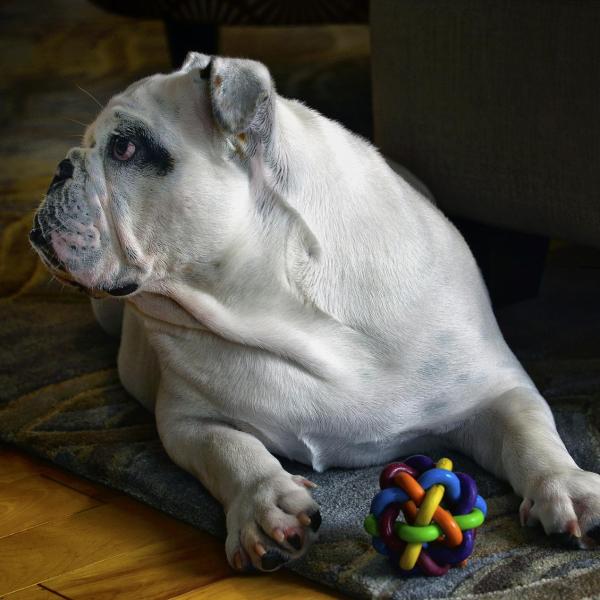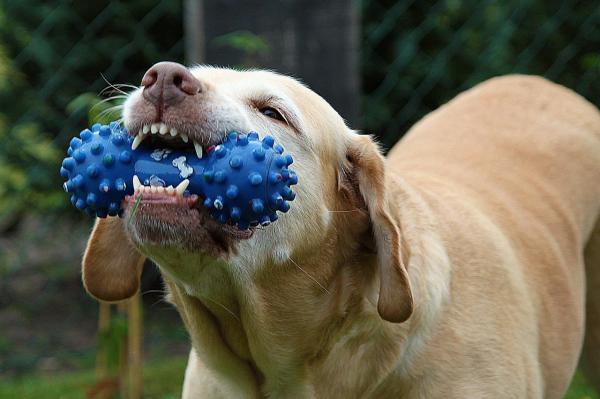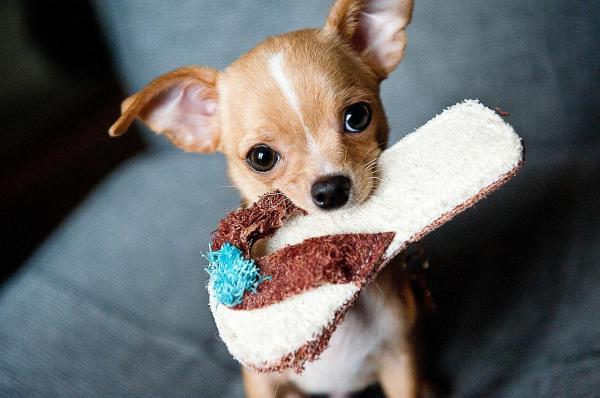
Dogs can be possessive with their toys: this is not a problem when they simply try to avoid us when we attempt to take them away, but it can become worrying when dogs growl or threaten to bite when approached. In that case, the dog is sending us a clear message: "This is mine, take another one".
When the situation is mild, you must take action now before losing control of the situation and risking it becoming a danger. As owners, we tend to worry about possessive behavior problems when we notice our dog growling or baring its teeth when we approach. As always, it is better to prevent these situations and focus on training even when no signs of possessiveness are shown.
Whether your dog is possessive with toys or are looking ways to prevent this problem, keep reading this AnimalWised article and discover the causes that may explain why is your dog possessive with toys.
Is your dog insecure?
A typical scenario for aggressiveness occurs when a dog claims possession of an object or a toy, or sometimes even a piece of territory. This type of behavior is called "resource protection", and it means that the dog will try to defend what it considers to be its property with a hostile attitude that can range from showing its teeth or growling to a lunge and full bite.
This behavior usually comes from a deep insecurity or fear, such as the fear of losing control of toys or its environment. The real problem lies in what your dog discovers after its aggression towards humans: we get frightened, intimidated and leave the dog alone, that is, it "wins".
Since the dog will feel satisfied and rewarded at "winning", this aggressive and possessive behavior will be positively reinforced, and it will repeated whenever it feels challenged by a rival.

What NOT to do when your dog is possessive
Another cause that can explain why your dog is possessive of its toys, or even aggressive, is the way in which some owners try to solve aggression with further aggression. When a dog is aggressive towards its owners for possession of an object, they may become aggressive in return and, for example, physically punish the dog or try to retrieve the object by force.
This only causes the dog to become increasingly aggressive in order to defend itself: very few owners get good results through this inadvisable practice. The end result will usually be some wounds and a dog that is even more aggressive and possessive with toys than before.
What factors influence possessiveness in dogs?
Although the possessive behaviors with toys that lead to aggression can occur in any dog, it is common to find a genetic component. Possessiveness occurs significantly in certain breeds or lines of dogs like the English Cocker Spaniel, the Border Collie, the Rottweiler, the Jack Russell and the Golden Retriever, among others.
Generally, behind a dog's possessive impulse is an over-sensitive perception of threat or even paranoia which usually has a genetic origin but which can be aggravated by stress and a lack of safety, deprivation or abuse in its first weeks of life.
Either way, this is what leads the dog to have an obsession with controlling its territory or its toys, to squeal before being hit or to continue to show aggressive behaviors even when you are not acting threateningly.

When does possessiveness become a problem?
In many dogs, possessiveness with toys or other objects can be strongly reduced or even completely solved thanks to the owner's coherence, firmness and authority without confrontation.
However, the problem can be deeper with other dogs. It lies in the erroneous perception that the dog has of the world around it, which it sees as a place of ongoing threats in which it has to exercise constant control. This misconception of the world is what can make possessiveness with toys become so dangerous.
If your dog has shown signs of aggressiveness due possessiveness of its toys, it is important to understand that it cannot be treated like any other dog that does not have this problem: you must consult a veterinarian or dog trainer for help.
Preventing possessiveness in dogs
When adopting a puppy, it is important that from the beginning all household members give it food and treats in its bowl and move their hands around it while giving it food. This way, your puppy dog will learn that people around its food is not a bad thing, but quite the opposite.
To avoid resource protection, we will offer it food straight from our hand occasionally, and let it see how we fill its bowl. It will also be very useful to touch its personal space and objects.
It is also important to teach from an early age the commands 'leave' and 'give'.
Leave:
To teach the command "leave", wait for your puppy dog to pick up a toy and instead of chasing it to get the toy, call it with a treat. When it releases the toy, say "leave" so it can learn this order by association. Congratulate it very much for its cooperation, then give it a treat and another toy to play with. Recover the toy you did not want it to have and repeat the exercise several times a day.
Give:
To teach the command "give", wait for your dog to take a toy in its mouth. With one hand gently hold the toy without pulling, and with the other show it a treat. As it releases the toy to get the treat, say "give" and congratulate it. After that, give the toy back. If you do not want it to keep this toy, give another one in return.
Note that if from a young age it never sees a toy again after you take it, your dog will learn that it has to be more possessive because if you take something it will be gone forever. This is why we give another toy in exchange in all cases.
Both exercises, practiced regularly, avoid confrontation and teach the dog how positive it is for it to cooperate with you and obey your orders.
It will be important in this training to use very tasty treats or snacks for dogs, which will be more tempting than the toy it wants to possess. Remember that it is essential that the dog does not believe you are trying to snatch it away. Knowing that it will get the toy back even if it releases it is very important in this procedure.

If you want to read similar articles to Why is my Dog Possessive with Toys?, we recommend you visit our Behavioral problems category.